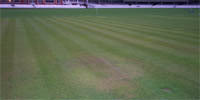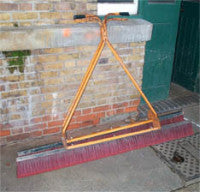The Lords Progression
The Lords Progression

By Mick Hunt.
The entire field of play at the MCC is sat on thick, virtually impermeable London clay and for many years has caused heartache and headaches for myself and my team. The old clay pipe drainage system has long since silted up so over the last few years some additional plastic perforated drainage pipes have been added. These pipes are installed at approximately ten metre centres, but the recent, heavy and prolonged spells of rain have shown these up to be inadequate.
The location of the ground in central London and the stadium itself, don't lend themselves to air movement. There could be a howling gale crossing the country but the air in the ground seems to remain quite still. Combine this with the shade problems created by the height of the stands and the surrounding buildings and I haven't much help to dry out either the wicket or the outfield.
At this time of year, the renovation is now over, we have some remedial repairs on the machinery and our
The drainage is my first priority and I may well decide on additional piping between the existing drains. I am looking at all of the possible alternatives in the market place. We have to balance getting the right system against cost. However there are a number of other considerations to be taken into account. Although Lords is used solely for cricket, there may come a time in the future when the stadium is used to host other non-cricket events. It makes clear business sense to incorporate a system during construction that would withstand future alternative usage.
I have started to look at reinforcement of the outfield using fibre mixed materials. There is already one good reason for this as we are soon to trial some special trays.
One of our recurring problems is that while cricket is being played in the stadium we obviously can't be preparing the next wicket for play. At present there are thirteen first class wickets on our square. This means that a wicket played on in April tends to be used again in June/July because of the limited space available.
The trays, which we hope to have in place by Christmas are the length and width of a wicket. They will be filled with loam, seeded and grown to establishment. Each tray will weigh about 35 tonnes, giving us the opportunity to play much more cricket at the ground. These trays will have to be transported to the square and dropped into a prepared hole ready for play, hence the fibre reinforced outfield.
By having four or five of these trays we will be able to prepare them outside of the stadium free from fixtures until they are required for use.


Finally we have also just levelled and re-turfed the bowler run ups as the square had started to rise noticeably through years of top dressing and we felt that it was high time to make these constructional changes. Over the coming months I will discuss in more detail our progress and more importantly the management of the trays and the logistics of a portable wicket.
